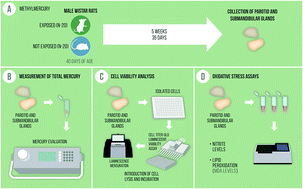Chronic intoxication by methylmercury leads to oxidative damage and cell death in salivary glands of rats
Abstract
Methylmercury (MeHg) is one of the most toxic species of mercury, causing several systemic damages; however, its effect on the salivary glands has rarely been explored to date. This study was aimed at analyzing the mercury deposit, oxidative stress markers, and cell viability in parotid and submandibular rat salivary glands after chronic methylmercury intoxication. Herein, forty male Wistar rats (40 days old) were used in the experiment. The animals of the experimental group were intoxicated by intragastric gavage with MeHg at a dose of 0.04 mg per kg body weight per day for 35 days, whereas the control group received only corn oil, a diluent. After the period of intoxication, the glands were obtained for evaluation of total mercury deposit, cell viability, and the malondialdehyde (MDA) and the nitrite levels. Our results indicated mercury deposits in salivary glands, with a decrease in cell viability, higher levels of MDA in both glands of intoxicated animals, and a higher concentration of nitrite only in the submandibular gland of the mercury group. Thus, the intoxication by MeHg was able to generate deposits and oxidative stress in salivary glands that resulted in a decrease in cell viability in both types of glands.



 Please wait while we load your content...
Please wait while we load your content...